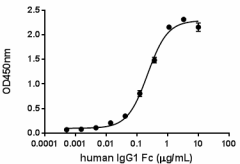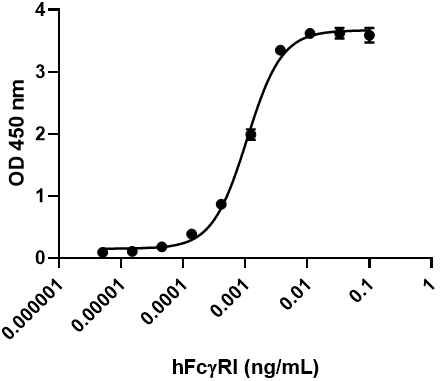- Regulatory Status
- RUO
- Other Names
- Low affinity immunoglobulin gamma Fc region receptor II-b, Fc fragment of IgG receptor IIb, IgG Fc receptor II-b, CDw32, Fc-gamma RII-b, FcγRII-b, FcRII-b, CD32b, FCGR2B
- Ave. Rating
- Submit a Review
- Product Citations
- publications

-

When recombinant human Fcγ RIIB/CD32b is immobilized at 2 µg/mL, human IgG1 Fc (Cat. No. 778302) binds with an EC50 of 0.15 – 0.6 µg/mL in a functional ELISA. -

Stability testing for Human Fcγ RIIB/CD32b. Recombinant human Fcγ RIIB/CD32b was aliquoted in PBS, pH 7.2 at 0.2 mg/mL. One aliquot was frozen and thawed four times (4x Freeze/Thaw), and compared to a control kept at 4°C (control). The samples were tested in a binding assay with human IgG1 Fc.
Fcγ RII, also known as CD32, are low affinity IgG Fc receptors. There are three distinct genes encoded (A, B, C) in humans and a single gene in mice. The Fcγ RII proteins share 89% sequence identity at the amino acid level in their extracellular domains, but their transmembrane and cytoplasmic domains differ significantly. Fcγ RIIA associates with FcRγ and induces an activating signal upon ligand binding, whereas Fcγ RIIB associates with FcRγ to induce an inhibitory signal. Fcγ RIIC is a cross-over between the RIIA and RIIB. Its extracellular domain shares 99% sequence identity at amino acid level with Fcγ RIIB, but the cytoplasmic domain is closely related to Fcγ RIIA. Fcγ RIIB, also known as CD32b, consists of an extracellular domain, a transmembrane region and a cytoplasmic tail containing an immunoreceptor tyrosine-based inhibition motif (ITIM). Fcγ RIIB negatively regulates cell activation, proliferation, endocytosis, phagocytosis, and degranulation. Fcγ RIIB is expressed on monocytes/macrophages, granulocytes, platelets and mast cells in humans.
Product DetailsProduct Details
- Source
- Human Fcγ RIIB/CD32b, amino acid Ala46-Pro217 (Accession# P31994), with a C-terminal 8x His tag, was expressed in 293E cells.
- Molecular Mass
- The 185 amino acid recombinant protein has a predicted molecular mass of approximately 20.8 kD. The DTT-reduced and non-reduced protein migrates at approximately 20 - 30 kD by SDS-PAGE. The predicted N-terminal amino acid is Ala.
- Purity
- >95%, as determined by Coomassie stained SDS-PAGE.
- Formulation
- 0.22 µm filtered protein solution is in PBS, pH 7.2.
- Endotoxin Level
- Less than 0.01 ng per µg cytokine as determined by the LAL method.
- Concentration
- 10 and 25 µg sizes are bottled at 200 µg/mL. 100 µg size and larger sizes are lot-specific and bottled at the concentration indicated on the vial. To obtain lot-specific concentration and expiration, please enter the lot number in our Certificate of Analysis online tool.
- Storage & Handling
- Unopened vial can be stored between 2°C and 8°C for up to 2 weeks, at -20°C for up to six months, or at -70°C or colder until the expiration date. For maximum results, quick spin vial prior to opening. The protein can be aliquoted and stored at -20°C or colder. Stock solutions can also be prepared at 50 - 100 µg/mL in appropriate sterile buffer, carrier protein such as 0.2 - 1% BSA or HSA can be added when preparing the stock solution. Aliquots can be stored between 2°C and 8°C for up to one week and stored at -20°C or colder for up to 3 months. Avoid repeated freeze/thaw cycles.
- Activity
- When human Fcγ RIIB/CD32b is coated at 2 μg/mL (100 μL/well), human IgG1 Fc (Cat. No. 778302) binds with an EC50 of 0.15 – 0.6 µg/mL in a functional ELISA.
- Application
-
Bioassay
- Application Notes
-
BioLegend carrier-free recombinant proteins provided in liquid format are shipped on blue ice. Our comparison testing data indicates that when handled and stored as recommended, the liquid format has equal or better stability and shelf-life compared to commercially available lyophilized proteins after reconstitution. Our liquid proteins are verified in-house to maintain activity after shipping on blue ice and are backed by our 100% satisfaction guarantee. If you have any concerns, contact us at tech@biolegend.com.
Antigen Details
- Structure
- Ig family molecule
- Distribution
-
Myeloid cells, monocytes, macrophages, dendritic cells, neutrophils, eosinophils and platelets; Plasma membrane
- Function
- Low affinity IgG Fc receptor, It is involved in phagocytosis, cytotoxicity, platelet aggregation and secretion
- Interaction
- Lyn, Hck protein tyrosine kinase
- Ligand/Receptor
- Aggregated IgG, IgG-antigen complex
- Cell Type
- Dendritic cells, Eosinophils, Macrophages, Mast cells, Monocytes, Neutrophils, Platelets
- Biology Area
- Immunology, Innate Immunity
- Molecular Family
- CD Molecules, Fc Receptors, Soluble Receptors
- Antigen References
-
- Bruhns P, et al. 2009. Blood. 113: 3716.
- Bewarder N, et al. 1996. Mol Cell Biol. 16: 4735.
- Descours B, et al. 2017. Nature 543: 564.
- Tomiyama Y, et al. 1992. Blood. 80: 2261.
- Indik Z, et al. 1991. J Clin Invest. 88: 1766.
- Ramsland PA, et al. 2011. J Immunol. 187: 3208.
- Hogarth PM and Pietersz GA. 2012. Nat Rev Drug Discov. 11: 311.
- Bournazos S, et al. 2009. J Immunol. 182: 8026.
- Maxwell KF, et al. 1999. Nat Struct Biol. 6: 437.
- Sandilands GP, et al. 1997. Immunology. 91: 204.
- Ghazizadeh S, et al. 1994. J Biol Chem. 269: 8878.
- Gillis C, et al. 2014. Front Immunol. 5: 254.
- Gene ID
- 2213 View all products for this Gene ID
- UniProt
- View information about Fcgamma RIIB/CD32b on UniProt.org
Related Pages & Pathways
Pages
Related FAQs
- Why choose BioLegend recombinant proteins?
-
• Each lot of product is quality-tested for bioactivity as indicated on the data sheet.
• Greater than 95% Purity or higher, tested on every lot of product.
• 100% Satisfaction Guarantee for quality performance, stability, and consistency.
• Ready-to-use liquid format saves time and reduces challenges associated with reconstitution.
• Bulk and customization available. Contact us.
• Learn more about our Recombinant Proteins. - How does the activity of your recombinant proteins compare to competitors?
-
We quality control each and every lot of recombinant protein. Not only do we check its bioactivity, but we also compare it against other commercially available recombinant proteins. We make sure each recombinant protein’s activity is at least as good as or better than the competition’s. In order to provide you with the best possible product, we ensure that our testing process is rigorous and thorough. If you’re curious and eager to make the switch to BioLegend recombinants, contact your sales representative today!
- What is the specific activity or ED50 of my recombinant protein?
-
The specific activity range of the protein is indicated on the product datasheets. Because the exact activity values on a per unit basis can largely fluctuate depending on a number of factors, including the nature of the assay, cell density, age of cells/passage number, culture media used, and end user technique, the specific activity is best defined as a range and we guarantee the specific activity of all our lots will be within the range indicated on the datasheet. Please note this only applies to recombinants labeled for use in bioassays. ELISA standard recombinant proteins are not recommended for bioassay usage as they are not tested for these applications.
- Have your recombinants been tested for stability?
-
Our testing shows that the recombinant proteins are able to withstand room temperature for a week without losing activity. In addition the recombinant proteins were also found to withstand four cycles of freeze and thaw without losing activity.
- Does specific activity of a recombinant protein vary between lots?
-
Specific activity will vary for each lot and for the type of experiment that is done to validate it, but all passed lots will have activity within the established ED50 range for the product and we guarantee that our products will have lot-to-lot consistency. Please conduct an experiment-specific validation to find the optimal ED50 for your system.
- How do you convert activity as an ED50 in ng/ml to a specific activity in Units/mg?
-
Use formula Specific activity (Units/mg) = 10^6/ ED50 (ng/mL)
 Login / Register
Login / Register 












Follow Us